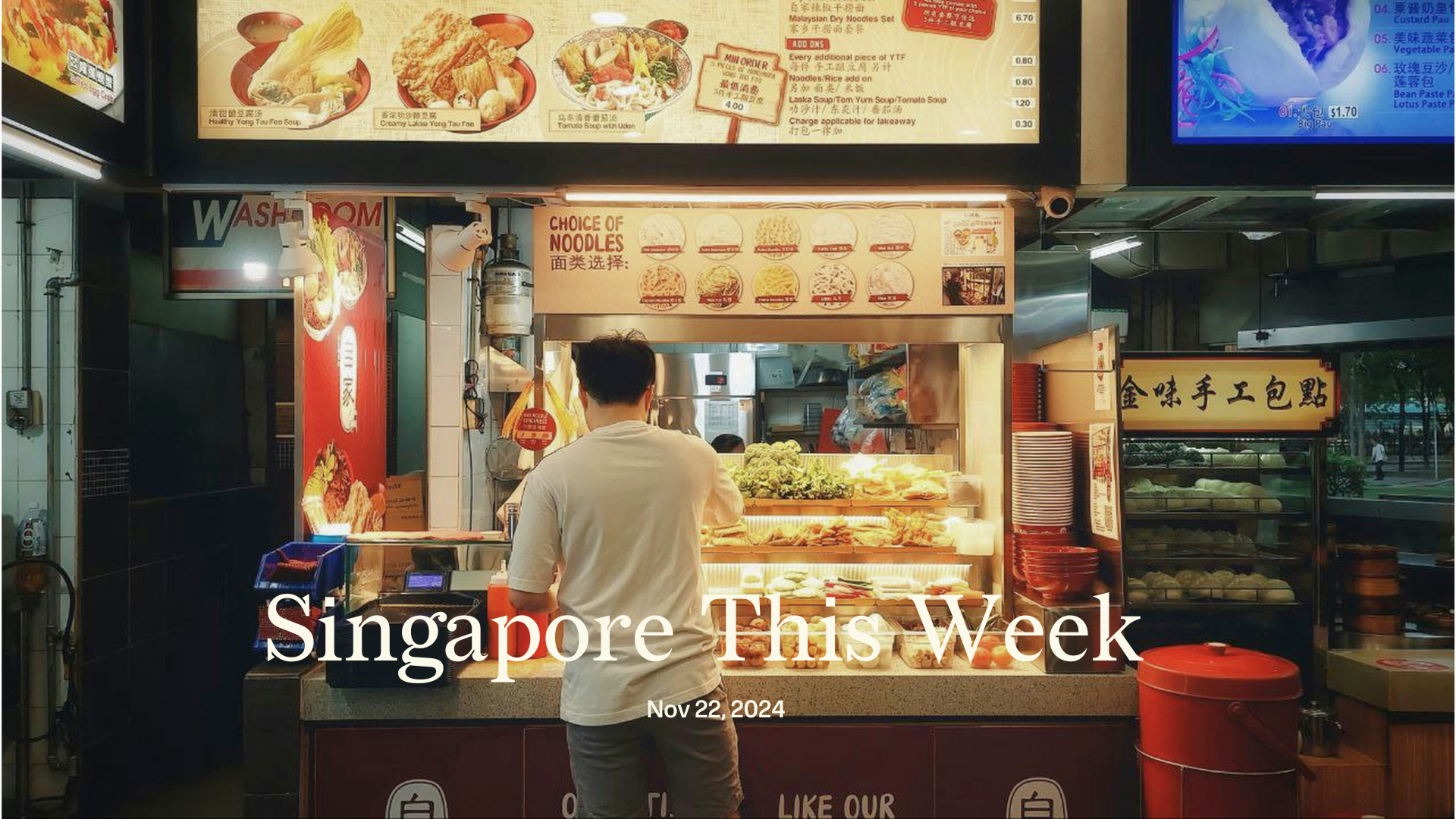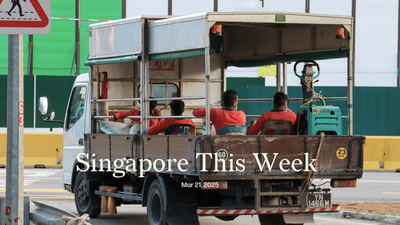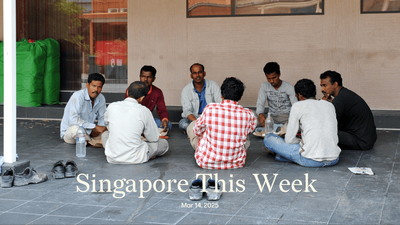Society: Michelin no enough
When millionaire politicians from the ruling People’s Action Party (PAP) glorify Singapore’s affordable hawker food, they are effectively celebrating the drastic inequalities in what’s sometimes called a “first world country with a third world wage structure”. The availability of sumptuous cuisine for a song, in one of the world’s costliest cities, is a reflection of the pitiful salaries throughout the food supply chain. From the drivers who transport produce to the hawkers themselves, each experiences a form of labour exploitation. It is part of a broader socio-economic edifice that excessively privileges capital over labour, landlords over tenants, rulers over subjects. The elite celebrate cheap hawker food in the same way they do cheap domestic help—outsourcing childcare and cooking for wages unheard of in rich democracies (though comparable to autocratic petro-states).
Without addressing these systemic injustices, political debates around hawker policies will be watery thin. Recent policy proposals by the Progress Singapore Party (PSP) include centralising hawker management and stabilising rents—antidotes to the free market—and allowing one foreign worker per stall. These were cheered by KF Seetoh, prominent food critic and co-founder of Makansutra. The PAP rebutted each proposal. For instance, hawkers and their staff must be local, so it goes, in order to protect the Singaporean identity of hawker centres. (Though long-term visit pass holders will be eligible from next year.) Nevertheless, Parliament unanimously passed an amended motion that called on the government to “...continue its support for hawkers by regularly reviewing its policies…” Revolutionary stuff. It’s unclear what meaningful change will result from the motion, though it was an opportunity for the PAP to posture as the protectors of hawkers and poorer Singaporeans (who depend on cheap food)—even as its very policies feed their respective crises.
Hawkers thus find themselves in the unenviable position of being both guardians of an “intangible cultural heritage”, as well as providers of sustenance for an entire underpaid class. More radical suggestions might include regular, widespread hawker centre subsidies for lower-income Singaporeans, thereby allowing hawkers to raise prices—improving their livelihoods and the attractiveness of the job—while still providing affordable meals to those who can’t afford them. Yet this will be as unappetising to the political aristocracy, allergic to welfare, as are the broader structural adjustments needed to nurture a more egalitarian society. The next time you’re in line for Hokkien mee, wondering how long it’ll take for those diverse ingredients to bubble into that heavenly, dripping mess, remember that your chef is both a portal to our rich, culinary past, and a poster child for our current capitalist malaise.
Society: Honesty and transparency will deter terror
Since 2015, 52 self-radicalised individuals have been dealt with under Singapore’s internal security laws, of which 13 are aged 20 or younger, according to the Internal Security Department (ISD). Youth radicalisation has come to the fore more prominently since last month’s news of a 17-year-old who allegedly planned to attack non-Muslim males in Tampines using either a kitchen knife or a pair of scissors.
In a commentary this week, Kumar Ramakrishna, dean of the S Rajaratnam School of International Studies, suggested three approaches to counter youth self-radicalisation: the need for an individual’s family, friends and community to detect warning signs; effective laws; and the need “to develop the emotional and intellectual resilience of youths against violent extremist ideology”. The last is particularly important, though unsurprisingly, Ramakrishna, a favoured establishment hawk, doesn’t mention the need for greater honesty and transparency from the government.
For instance, the best way to improve faith in Singapore’s pre-emptive detentions is for the ISD to engage in a transparent review of all its previous operations, including Operation Coldstore and Operation Spectrum. Otherwise, it’ll always be tainted by the suspicion that it’s acting to counter political rather than security threats. (Historians Ramakrishna and PJ Thum have crossed swords on this point before.)
Similarly, given that Israel’s war on Gaza has apparently precipitated a fresh bout of self-radicalisation globally, the government should be promoting open discourse on Singapore’s relationship with Israel. For instance, why did The Straits Times (ST) seemingly censor the fact that the Singapore government may have purchased and used Israeli spyware? Why does the government refuse to release details of its arms trade with Israel? “National security” is the common excuse given for this opacity—though it is this very lack of openness in a supposed democracy that enables bigotry to fester, that makes disenfranchised youth more vulnerable to extremism.
Society: Stability, self-reliance and social mobility for lower-income families, but what about the ‘sandwich class’?
Last year, fewer lower-income families received Community Care (ComCare) financial aid from the government, the result of an expanded job market, buoyed by the post-pandemic economic recovery, and support from other government schemes. The number of households receiving short-to-medium-term assistance (SMTA) has continued to decline since 2021, when it hit a peak of 36,853, before dropping to 22,960—pre-Covid levels—last year. The total amount disbursed fell to S$105.1m in 2023, from a peak of about S$170m in 2020. Similarly, the share of families returning to SMTA within 36 months of leaving also dropped. The latest figures were released by the Ministry of Social and Family Development (MSF) in its Supporting Lower-Income Households Trends Report.
ComCare provides three major types of financial assistance for households that are temporarily or permanently unable to meet their daily living expenses, helping to stabilise their circumstances and ultimately achieve social mobility. The numbers receiving long-term assistance (LTA), who are permanently unable to work and have little or no family support, has also shrunk. MSF attributes the dip to more residents working longer years, younger cohorts of elderly having more savings, and increased government social support. LTA offers a fixed amount depending on the number of people in the family. With SMTA, amounts vary and are customised to each household’s compositions, needs and incomes. The third aid option is the student care fee assistance for children from lower-income families.
These numbers bode well for the success of government financial aid schemes like ComCare, which use means testing to determine who gets assistance given the limited resources available. Globally, means testing has been roundly praised for ensuring that help reaches those who most need it, but also criticised for being unfair and expensive to administer, as well as hurting those who are “neither rich [n]or very poor”. Stuck between the haves and have-nots, a “sandwich generation” earns too much to qualify for significant government assistance or other forms of financial aid, but not enough to escape the pressures of financial precarity and the inability to save for rainier days. This segment of Singaporeans—composed of those aged between 40 and 60 who are caring for their children and ageing parents—can surely benefit from more financial assistance, but are often excluded. Help for the sandwich class was a key issue at recent budget debates. Jom’s recent voter sentiment survey suggested that this group is the most dissatisfied with the government, and life overall.
Some further reading: “The Singapore Dream fades for the ‘sandwich class’” by Reeta Raman.
Society: Setting higher standards, for ourselves
More personal space. Better beds. Larger communal areas. There is much to like about the new foreign worker dormitory in Jurong. The first such government facility—the Ministry of Manpower (MoM) built and owns it—is expected to be ready by early-2026. A second dorm, in Sengkang, will be constructed by mid-2028. The MoM wants to show private dorm operators “some of the improvements [in worker’s living arrangements] that are just not necessary, but also commercially viable,” Tan See Leng, manpower minister, told ST.
The Covid-19 pandemic exposed the deplorable conditions under which migrant workers live, and exacerbated them too. The powers-that-be have since created a two-stop roadmap for private operators. By 2030, there will be requirements for greater personal space, a maximum of 12 residents will be allowed per room, and each room will have to be equipped with two en-suite bathrooms. Currently, there are no limits on the number of workers who can be crammed into a single room, and the mandatory worker-to-bathroom ratio is 15:1. By 2040, some of the new standards will become more stringent, and others, like mandatory Wi-Fi in all rooms, will be enforced.
Some may find this an inordinately long process for a nation otherwise so keen to tout its efficiency. Even the new MoM dorms appear to have been delayed; in 2021 ST had reported that they would be ready in three years. Perhaps if workers had demanded an apology for the way they were treated during the pandemic, it would have expedited matters. Much of the language around better living conditions is couched in infection control terms, rather than an acknowledgement that we can and should have done better by our workers a long time ago. And some of the improvements seem gimmicky–the “privacy nook”, for instance, appears to be a sign slapped on walls at the end of corridors. Finally, only 1,000 of the 1,500 dorms will be required to meet the new standards by 2040.
Yet, to only criticise would be churlish. Some features in the new dorm show genuine consideration. Among them, free Wi-Fi; better bunk-bed design; an emphasis on open, green spaces; and facilities to play cricket—a favourite among those from the sub-continent. These are vital steps in our national growth. The more we humanise our workers, the more we recover our collective humanity.
History weekly by Faris Joraimi
For hundreds of historical objects in South-east Asia, it’s the season of homecoming. Last week, the US embassy in Thailand voluntarily returned four artefacts to the Fine Arts Department (an agency under the Thai ministry of culture that manages archaeological sites and objects in the country). The four objects include 3,000-year-old pottery and clay tools from Ban Chiang in north-eastern Thailand, a rich archaeological site whose bronzeware and ceramics have been heavily trafficked since discovery in 1966. The US embassy got the objects from an American soldier, who actually received them as a gift from the Thai government in the 1960s. At the handover ceremony, the American ambassador said, “Now is the right time to return these precious items back to their rightful home.” But nothing else explains the embassy’s sudden decision, and the Thai government reportedly didn’t even know these objects existed until the embassy told them. But Heaven knows the US needs all the good karma it can get these days. They just returned two sculptures in May—one of Shiva and another of a kneeling woman—from New York’s Metropolitan Museum of Art to Bangkok’s National Museum. Americans aren’t the only Westerners with noblesse oblige: the Dutch government returned 288 stolen weapons, coins, jewellery and textiles to its ex-colony Indonesia (after the Indonesian government officially requested these objects to be returned last September). Six were taken from Javanese temples in the 19th century, while the rest were taken during the conquest of southern Bali in 1906, when the Dutch invaded the kingdoms of Badung and Tabanan.
Eppo Bruins, the Dutch minister of education, culture and science, said “There was looting and pillaging going on in the colonial period and other types of involuntary loss of cultural objects. It is a matter of material justice to return them.” In the debate around repatriating historical artefacts, a common criticism is that “poorer” countries don’t have the resources or infrastructure to adequately maintain antiques valuable to humanity. First World condescension aside, this is increasingly no longer true for many South-east Asian countries. The other issue: are national governments, claiming to be these objects’ “rightful” owners, necessarily the legitimate successors of the now-defunct kingdoms from which these objects were taken? This gets complicated when you have two governments claiming to be the true representative of one national history: the imperial treasures of the Forbidden City are now split between the Republic of China (Taiwan) and the People’s Republic of China. Bo pian, must share. But how far is the Indonesian government in Jakarta the successor to Badung and Tabanan? Will these objects be kept in Bali? Should the “Benin Bronzes”—art looted by British troops from the kingdom of Benin in 1897—be “returned” to present-day Nigeria (est. 1960), or Benin’s living hereditary ruler, the oba? Of course we can all agree in principle that colonisers should “return” what they stole, but the often more complicated question is: to whom?
Arts: A language of no significance?
One film to make your middle-aged Chinese uncle mourn his mid-life career crisis, another to make him wish he’d been a better father: this is how you get your stoic dad to cry, even if it’s just at the movies. The sentiment-soaked films “A Year of No Significance” and “Wonderland” were recently named “Most Anticipated Chinese-Language Films (Overseas Regions)” at China’s annual Golden Rooster Awards. Ironically enough, Hokkien’s the language of choice in both, and each sad-sack, down-on-their-luck male protagonist wrestles with the fallout of Singapore’s overzealous “Speak Mandarin Campaign” that effectively wiped Sinophone dialects from the nation in a single generation. Chai Yee Wei, who directed “Wonderland”, called its approval for public local screening a “miracle” and wondered aloud if “[i]n another generation or two, we might lose the ability to speak in this form [of Hokkien]”. Similarly, Kelvin Tong, at the helm of “A Year of No Significance”, told Variety that the policies of the 1970s “affected a lot of people in ways profound and intimate. It’s not a subject that is discussed often...As that generation of the Chinese-educated is dying out, I felt compelled to make a film about them before they are all gone.” While the Infocomm Media Development Authority’s classification guidelines state that films with dialect content are allowed only on “a case-by-case basis” and “should generally be in Mandarin, in line with the Speak Mandarin Campaign”, neither filmmaker should have been unduly worried. Where the state once axed dialects from airwaves and classrooms, it’s also now over-compensating by deploying dialects as flavour in the bland bilinguality of our formerly polyglot country. Ong Ye Kung, minister for health, publicly conceded: “It may not have much commercial value, but dialects do have the effect of bringing people closer.” Linguistic disenfranchisement may be going from counterculture to over-the-counter, gaining currency as a cinematic trope and surefire shortcut to unker nostalgia.
Another Singaporean film we might want to pay more attention to is Chiang Wei Liang’s “Mongrel”, fresh off the awards circuit. Performed in Mandarin, Taiwanese and Thai, the unflinching drama follows Oom, an undocumented Thai migrant, who works as a caregiver for the disabled and elderly in rural Taiwan. He must contend with exploitative employers and challenging clients, and the very same issues of withheld wages and restricted mobility that many of Singapore’s transient workers face every day. Next month, “Mongrel” will be screened both at the Singapore International Film Festival and also as a fundraiser for the non-profit Humanitarian Organisation for Migration Economics (HOME), which has in its 20 years worked with over 40,000 migrant workers, including those weathering abuse, homelessness and deportation.
Business: Foodpanda gets a black eye
The Competition and Consumer Commission of Singapore (CCCS) has issued a warning to food delivery platform Foodpanda, for an advertisement promising “unlimited free delivery on all restaurants” for Pandapro subscribers. CCCS found that the ad, which ran from July 1st to September 30th, was misleading. Subscribers only received discounts. More than 40 percent of food delivery transactions during this period still required a residual delivery fee. Foodpanda has agreed to provide full refunds to affected subscribers, and must review all its marketing materials to ensure compliance with fair trading laws. Pricing and delivery fees are crucial factors for consumers in the competitive food delivery market. Hopefully, CCCS’s intervention will warn others in the sector to keep pricing transparent and advertising claims accurate. Furthermore, the CCCS’s emphasis on the use of terms like “$0” or “free” and the insufficiency of generic disclaimers like “terms and conditions apply” provides valuable guidance for businesses operating in Singapore’s larger digital economy.
Tech: More support for returning moms
Childcare responsibilities often take moms out of the workforce for several years; re-entry is hard. The Relaunch programme by the Infocomm Media Development Authority (IMDA) will provide structured training programmes, career integration support, mentorship, and networking opportunities for women returning to tech careers after breaks. Josephine Teo, minister for digital development and information, said such support was even more important given the steep learning curves engendered by advancements in technology. Twenty-three companies and organisations, including Ant International Foundation, LinkedIn, Visa, and Grab, have committed to Relaunch. There has been a significant increase in the number of tech companies offering programmes to support women, from 31 percent in 2020 to 56 percent in 2023. The Singapore Computer Society and vLookUp.ai have a mentorship programme; while Tata Consultancy Services plans to hire 50 returning women in tech by 2025. Both companies are also Relaunch partners. This is an encouraging trend, indicating a deepening commitment to gender diversity and inclusion.
Tech: We-won’t-work
WeWork is not working out in Singapore. In the latest pullback of the co-working industry in the city-state, the company has ceased operations in Manulife Tower, and plans to close another three-floor space at UE Square by 2025. WeWork remains committed to its 12 remaining spaces in Singapore, indicating a strategic realignment rather than a complete withdrawal from the market. Demand for prime office space has fluctuated over the past few years. Following the Covid-19 pandemic, workers returned en masse to offices. However, recent data from Jones Lang LaSalle shows a spike in prime office vacancies in Singapore, reaching the highest level in over two years during the third quarter. This is despite rents being unchanged.
One possible reason for the decline in co-working space popularity could be a shift in tenant behaviour, with some larger companies opting to consolidate their office spaces at the expense of co-working arrangements. A prime example is Chinese tech giant Tencent Holdings, which gave up a WeWork space at 30 Raffles Place earlier in 2024, choosing instead to open a new office at another prime tower. This situation unfolds against the backdrop of WeWork’s broader financial challenges, including its recent exit from bankruptcy in May. The company’s struggles in Singapore, a market once seen as promising, reflect the complex dynamics of the co-working industry and the evolving needs of businesses in a post-pandemic world.
If you enjoy Jom’s work, do get a paid subscription today to support independent journalism in Singapore.








